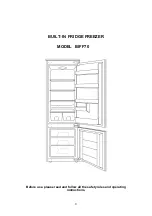
10
Care and Maintenance
Cleaning Your Refrigerator
1.
Unplug the unit and remove the food, shelves and crisper.
:
2.
Wash the inside surfaces with a solution of warm water and baking soda. The
solution should contain about 2 tablespoons of baking soda to a quart of
water. Rinse and dry thoroughly with a clean soft cloth.
3.
Wash the shelves and crisper with a mild detergent solution. Rinse and dry.
4.
Wash the outside cabinet with warm water and mild liquid detergent. Rinse
well and wipe dry with a clean soft cloth.
5.
Wring excess water out of the sponge or cloth before cleaning the area of the
controls, or any electrical parts.
CAUTION
: Failure to unplug the unit could result in electrical shock or personal
injury. Never use acids, chemical thinners, gasoline, benzene or hot water for
cleaning any part of the refrigerator-freezer. Also avoid any harsh cleansers
or abrasive cloths or cleaning pads.
Cleaning the Evaporation Tray
The evaporation tray is set at the back of the refrigerator-
freezer, just above the compressor. Since dust and
grime accumulating on this tray will decrease the
evaporation efficiency, it should be cleaned every six
months or so.
:
To remove the evaporation tray, unscrew it and slide it
out. Clean it as you would any other plastic part. Once
the tray is clean, reposition it over the compressor, making sure that it is level
and attached properly.
Power Failure
Most power failures are corrected within a few hours and should not affect the
temperature of your unit if you minimize the number of times the doors are
opened. If the power is going to be off for a longer period of time, you need to
take the proper steps to protect your food.
:
Vacation Time:
Short vacations: Leave the appliance operating during vacations of less than
three weeks.
Long vacations: If the unit will not be used for several months, remove all food
and unplug the power cord. Clean and dry the interior thoroughly. To prevent
odor and mold growth, leave the doors open slightly, blocking them open if
necessary.
































